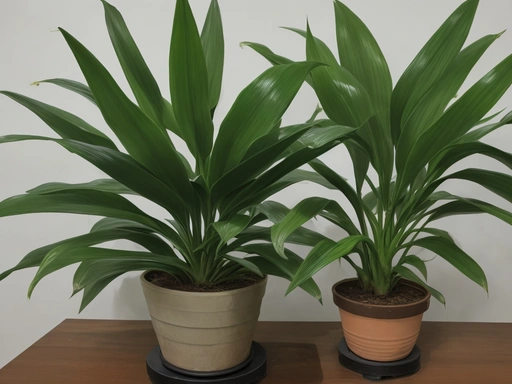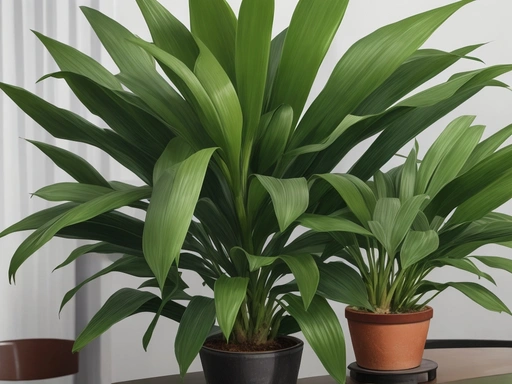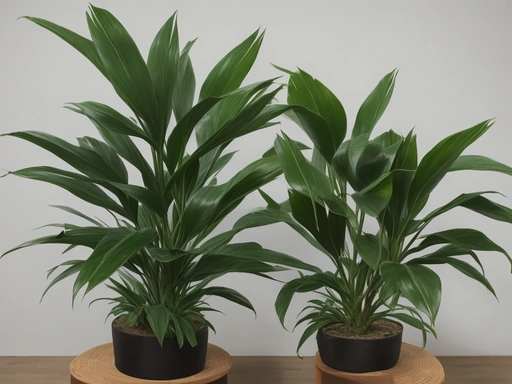Watering Schedule For Dracaena Plants: Optimal care for your indoor oasis
Key Takeaways:
- Water Dracaena plants thoroughly but infrequently to avoid overwatering.
- Allow the top inch of soil to dry out before watering again.
- Adjust watering frequency based on the plant’s environment and season.
- Use distilled or filtered water to avoid mineral buildup in the soil.
Are you struggling to keep your Dracaena plants alive and thriving? Well, I have great news for you! The secret lies in creating a proper watering schedule for these beautiful indoor plants.
Don’t worry, I’m here to guide you through it.
In this article, we will explore the importance of a watering schedule for Dracaena plants and how it can benefit their overall health. We’ll also discuss factors to consider when creating a watering schedule, understand the watering needs of Dracaena plants, and provide you with some handy tips for proper watering techniques.
So, let’s get started and transform your Dracaena plants into lush, vibrant wonders!
| Time of Year | Watering Frequency |
| Spring | Every 7-10 days |
| Summer | Every 5-7 days |
| Fall | Every 10-14 days |
| Winter | Every 14-21 days |
The Importance of a Watering Schedule for Dracaena Plants
A watering schedule is crucial for Dracaena plants to ensure their health and growth.
Why is a watering schedule important for Dracaena plants?
A watering schedule is important for Dracaena plants because it helps maintain consistent moisture levels in their soil.
This ensures that they receive the right amount of water without being over or under watered.
Consistency is key for these plants to thrive and prevent root rot or dehydration.

How can a watering schedule benefit Dracaena plants?
A watering schedule benefits Dracaena plants by providing them with consistent and appropriate moisture levels. This helps prevent overwatering orDracaena plants include yellowing leavesl to the plant’s health.
It also promotes root development, assists in nutrient absorption, and maintains overall plant vigor.
Factors to consider when creating a watering schedule for Dracaena plants
To create a watering schedule for your Dracaena plants, there are a few key factors to consider. First, take note of the specific variety of Dracaena that you have, as different varieties may have slightly different watering needs.
Next, consider the environment in which your Dracaena plants are located.
Factors such as temperature, humidity, and sunlight can all impact their watering requirements. For example, if your plants are in a hot and dry environment, they may require more frequent watering.
Another factor to consider is the size of the pot and the type of soil used.
Dracaena plants should be planted in well-draining soil, as they are susceptible to root rot if the soil becomes waterlogged. Smaller pots with less soil will dry out more quickly and may require more frequent watering.
Lastly, pay attention to the signs that your Dracaena plants give you.
If the leaves are turning yellow or drooping, it may be a sign of overwatering. On the other hand, if the leaves are wilting or the soil feels dry to the touch, it may indicate that your plants need to be watered more often.
Dracaena plants stay healthy and adjusting your watering schedule accordingly, you can ensure that your Dracaena plants stay healthy and thrive in their environment.
Understanding the Watering Needs of Dracaena Plants
To properly care for your Dracaena plants, it’s important to understand their watering needs.
How often should you water Dracaena plants?
Dracaena plants should be watered when the top inch of their soil feels dry to the touch.
This typically translates to watering them about once every 1-2 weeks.
Avoid overwatering, as it can lead to root rot, and underwatering, as it can cause the leaves to droop and turn yellow.
Monitor the moisture level of the soil and adjust the watering frequency accordingly.

Signs of overwatering in Dracaena plants
Signs of overwatering in Dracaena plants include yellowing leaves, wilting, root rot, and a foul odor. The soil may feel excessively wet or waterlogged.
Remove excess water and adjust your watering schedule to prevent further damage.

Signs of underwatering in Dracaena plants
Signs of underwatering in Dracaena plants include wilting leaves, dry and crispy foliage, yellowing or browning of leaves, stunted growth, and soil that feels dry to the touch. These signs indicate that the plant is not receiving enough water and needs to be watered more frequently.
Tips for watering Dracaena plants properly
To properly water your Dracaena plants, here are some tips:
- Check the moisture level of the soil before watering. Stick your finger about an inch into the soil – if it feels dry, it’s time to water.
- Water thoroughly, allowing the water to penetrate the entire root ball.
- Avoid overwatering by ensuring that the pot has proper drainage. Empty any excess water from the saucer or tray beneath the pot.
- Use room temperature or lukewarm water to prevent shocking the roots.
- Adjust your watering frequency based on the season – Dracaena plants generally require less water during winter months.
- Consider the specific variety of Dracaena you have and its unique watering needs. Some varieties may tolerate drier conditions better than others.
Remember, it’s essential to observe your Dracaena plant and adjust your watering routine accordingly to keep it happy and healthy.
Creating a Watering Schedule for Dracaena Plants
To create a watering schedule for your Dracaena plants, consider factors such as the plant variety, environmental conditions, and the moisture requirements of these plants.
Factors to consider when creating a watering schedule for Dracaena plants
To create an effective watering schedule for your Dracaena plants, there are a few important factors to consider.
These factors include the specific watering needs of your Dracaena variety, the time of year, and the environmental conditions in which your plant is located.
- Dracaena variety: Different Dracaena varieties have different watering requirements. Some varieties prefer more frequent watering, while others can tolerate drier conditions. Research the specific watering needs of your Dracaena variety to ensure you meet its requirements.
- Time of year: The time of year affects the watering needs of your Dracaena plants. During the warmer months, when the temperatures are higher, your plants may need more frequent watering. In contrast, during the cooler months or dormant period, your plants may require less water.
- Environmental conditions: Consider the environmental conditions in which your Dracaena plants are located. Factors such as humidity levels, sunlight exposure, and air circulation can impact their watering needs. For example, plants in direct sunlight or dry environments may require more frequent watering.
- Potting and soil: The type of pot and soil you use can also affect the watering schedule. Choose well-draining pots and a suitable potting mix, as excessive moisture retention can lead to root rot. Check the moisture level of the soil regularly to avoid overwatering or underwatering.
Remember, it’s essential to monitor your Dracaena plants regularly and adjust the watering schedule as needed.
Observe their leaves and soil moisture levels to determine if they need watering.
By considering these factors, you can create a watering schedule that promotes optimal growth and health for your Dracaena plants.
Factors that may affect the watering needs of Dracaena plants
The factors that may affect the watering needs of Dracaena plants include:
- The type of soil: Well-draining soil helps prevent waterlogging, while poorly-draining soil may require less frequent watering.
- The size of the plant: Larger plants generally require more water than smaller ones.
- Environmental conditions: Factors like temperature, humidity, and sunlight can affect how quickly a plant’s soil dries out.
- Seasonal variations: Plants tend to need less water during winter months when they are not actively growing as compared to warmer months.
- Plant growth stage: Younger plants may require more frequent watering to establish their root systems, while older plants may need less.
- Pot size: Smaller pots dry out faster, so plants in smaller pots may need more frequent watering than those in larger pots.
Remember to consider these factors when creating a watering schedule for your Dracaena plants to keep them happy and healthy.
Recommended watering frequency for different Dracaena varieties
Dracaena varieties have different watering needs, but water your Dracaena plantecommended to water them thoroughly when the top inch of soil feels dry. Here’s a breakdown by variety:
- Dracaena marginata: Water every 7-10 days.
- Dracaena fragrans: Water every 7-14 days.
- Dracaena reflexa: Water every 7-14 days.
- Dracaena sanderiana (Lucky Bamboo: Keep the roots submerged in water at all times.
Remember to adjust the watering frequency based on your specific environmental conditions and the size of your plant.
Adjusting the watering schedule according to seasons
Adjusting the watering schedule for Dracaena plants according to the seasons is important to ensure their optimal growth and health. During the warmer months, when the plant is actively growing, you may need to water more frequently.
In contrast, during colder months or periods of dormancy, you should reduce watering to prevent overwatering.
Always monitor the moisture level of the soil and adjust accordingly to meet the plant’s needs.
Tips for Properly Watering Dracaena Plants
To properly water your Dracaena plants, pay attention to the best time of day, the amount of water needed, the importance of drainage trays and pots, and the right watering techniques for potted plants.
The best time of day to water Dracaena plants
The best time of day to water Dracaena plants is in the morning. Watering in the morning allows the plants to absorb the moisture and use it throughout the day for growth.
It also helps prevent issues like fungal diseases that can occur when the leaves stay moist for too long.
Avoid watering at night, as this can lead to excessive moisture and create a favorable environment for pests and diseases. Additionally, watering in the morning ensures that any excess water on the leaves can dry off during the day, reducing the risk of leaf damage.
So, make it a habit to water your Dracaena plants in the morning to keep them healthy and thriving.
How much water should you give to Dracaena plants?
The amount of water you should give to Dracaena plants depends on several factors such as the size of the plant, the type of pot it’s in, the humidity levels, and the season. As a general rule, water your Dracaena plant thoroughly when the top inch of soil feels dry.
Avoid overwatering, as it can lead to root rot.
Remember to adjust the watering frequency accordingly during different seasons.
The importance of watering drainer trays and pots
Watering drainer trays and pots is important because they help prevent waterlogging and root rot by allowing excess water to drain away. It ensures proper moisture levels in the soil and prevents the plant from sitting in stagnant water.
This promotes healthy root growth and reduces the risk of overwatering.
Additionally, draining trays and pots prevent damage to furniture or surfaces by collecting excess water.
Watering techniques for potted Dracaena plants
Water potted Dracaena plants by thoroughly soaking the soil until water drains out of the pot’s drainage holes. Allow the top inch of soil to dry out before watering again.
Avoid overwatering, as it can lead to root rot.
Use room temperature water and avoid watering the foliage.
Frequently Asked Questions
What should I do if I accidentally overwatered my Dracaena plant?
If you accidentally overwater your Dracaena plant, the first thing to do is to remove any excess water from the pot.
Allow the soil to dry out completely before watering again.
Check for signs of root rot, such as mushy or discolored roots.
Prune any affected roots and repot the plant in fresh, well-draining soil.
Adjust your watering schedule to prevent future overwatering.
Can I use tap water to water my Dracaena plants?
Yes, you can use tap water to water your Dracaena plants. However, it’s important to note that tap water can contain chemicals like chlorine and fluoride, which may be harmful to the plants over time.
To minimize any potential damage, you can let the tap water sit out for 24 hours to allow these chemicals to evaporate.
Alternatively, you can use filtered or distilled water for watering your Dracaena plants.
How do I know if my Dracaena plant needs watering?
To know if your Dracaena plant needs watering, check the soil moisture level.
Stick your finger about one inch into the soil.
If it feels dry, it’s time to water.
Also, look for signs like droopy or yellow leaves and wilting.
These indicate that your plant needs a drink!
Can Dracaena plants tolerate dry conditions?
Dracaena plants can tolerate some dry conditions, but they prefer consistent moisture.
In general, it’s best to let the top inch of soil dry out before watering again.
However, if the soil becomes completely dry, the plant may suffer.
It’s important to find the right balance and avoid overwatering or underwatering.
Final Verdict
A watering schedule is crucial for the health and well-being of Dracaena plants.
It ensures that they receive the right amount of water at the right time, preventing issues like overwatering or underwatering.
Factors such as the type of Dracaena variety, environmental conditions, and potting medium should be considered when creating a watering schedule.
By properly watering your Dracaena plants, you can promote growth, prevent diseases, and maintain their overall vitality.
Remember to observe signs of overwatering or underwatering and adjust the watering schedule accordingly to meet their specific needs.







